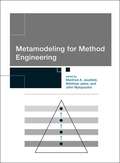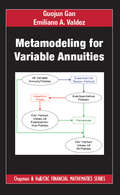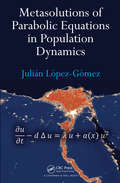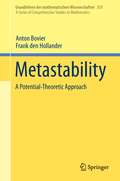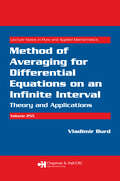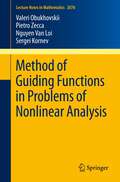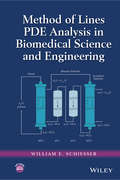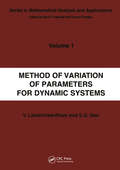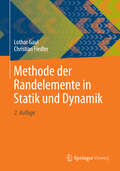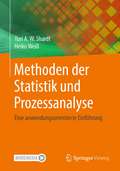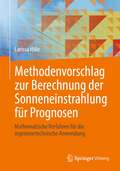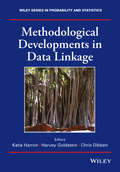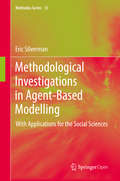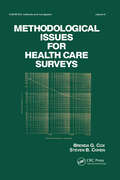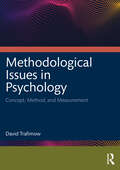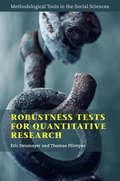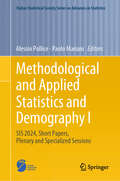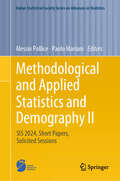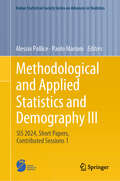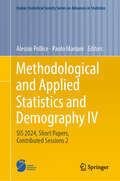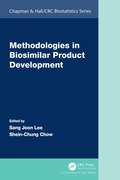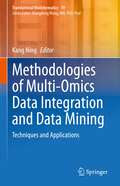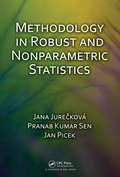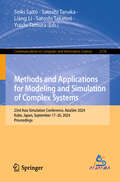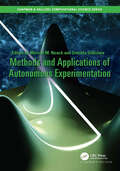- Table View
- List View
Metamodeling for Method Engineering
by Manfred Jeusfeld Matthias Jarke John MylopoulosThis text is a guide to the foundations of method engineering, a developing field concerned with the definition of techniques for designing software systems. The approach is based on metamodeling, the construction of a model about a collection of other models. The book applies the metamodeling approach in five case studies, each describing a solution to a problem in a specific domain. Suitable for classroom use, the book is also useful as a reference for practitioners. The book first presents the theoretical basis of metamodeling for method engineering, discussing information modeling, the potential of metamodeling for software systems development, and the introduction of the metamodeling tool ConceptBase. The second, and larger, portion of the book reports on applications of the metamodeling approach to method engineering. These detailed case studies range from telecommunication service specification, hypermedia design, and data warehousing to cooperative requirements engineering, chemical device modeling, and design of new abstraction principles of modeling languages. Although these chapters can stand alone as case studies, they also relate to the earlier theoretical chapters. The metamodeling approach described in the book is based on the Telos metamodeling language implemented by the ConceptBase system. An accompanying CD-ROM contains the ConceptBase system and a large collection of Telos metamodels discussed in the text. The CD-ROM enables readers to start directly with method engineering, from small method chunks up to complete method definitions. The complete definition of Ed Yourdon's structured analysis method is included as an instructional example.
Metamodeling for Variable Annuities (Chapman and Hall/CRC Financial Mathematics Series)
by Guojun Gan Emiliano A. ValdezThis book is devoted to the mathematical methods of metamodeling that can be used to speed up the valuation of large portfolios of variable annuities. It is suitable for advanced undergraduate students, graduate students, and practitioners. It is the goal of this book to describe the computational problems and present the metamodeling approaches in a way that can be accessible to advanced undergraduate students and practitioners. To that end, the book will not only describe the theory of these mathematical approaches, but also present the implementations.
Metasolutions of Parabolic Equations in Population Dynamics
by Julián López-GómezMetasolutions of Parabolic Equations in Population Dynamics explores the dynamics of a generalized prototype of semilinear parabolic logistic problem. Highlighting the author's advanced work in the field, it covers the latest developments in the theory of nonlinear parabolic problems.The book reveals how to mathematically determine if a species maintains, dwindles, or increases under certain circumstances. It explains how to predict the time evolution of species inhabiting regions governed by either logistic growth or exponential growth. The book studies the possibility that the species grows according to the Malthus law while it simultaneously inherits a limited growth in other regions.The first part of the book introduces large solutions and metasolutions in the context of population dynamics. In a self-contained way, the second part analyzes a series of very sharp optimal uniqueness results found by the author and his colleagues. The last part reinforces the evidence that metasolutions are also categorical imperatives to describe the dynamics of huge classes of spatially heterogeneous semilinear parabolic problems. Each chapter presents the mathematical formulation of the problem, the most important mathematical results available, and proofs of theorems where relevant.
Metastability
by Anton Bovier Frank Den HollanderThis monograph provides a concise presentation of a mathematical approach to metastability, a wide-spread phenomenon in the dynamics of non-linear systems - physical, chemical, biological or economic - subject to the action of temporal random forces typically referred to as noise, based on potential theory of reversible Markov processes. The authors shed new light on the metastability phenomenon as a sequence of visits of the path of the process to different metastable sets, and focuses on the precise analysis of the respective hitting probabilities and hitting times of these sets. The theory is illustrated with many examples, ranging from finite-state Markov chains, finite-dimensional diffusions and stochastic partial differential equations, via mean-field dynamics with and without disorder, to stochastic spin-flip and particle-hop dynamics and probabilistic cellular automata, unveiling the common universal features of these systems with respect to their metastable behaviour. The monograph will serve both as comprehensive introduction and as reference for graduate students and researchers interested in metastability.
Method of Averaging for Differential Equations on an Infinite Interval: Theory and Applications (Lecture Notes in Pure and Applied Mathematics)
by Vladimir BurdIn recent years, mathematicians have detailed simpler proofs of known theorems, have identified new applications of the method of averaging, and have obtained many new results of these applications. Encompassing these novel aspects, Method of Averaging of the Infinite Interval: Theory and Applications rigorously explains the modern theory of the me
Method of Guiding Functions in Problems of Nonlinear Analysis
by Valeri Obukhovskii Sergei Kornev Nguyen Van Loi Pietro ZeccaThis book offers a self-contained introduction to the theory of guiding functions methods, which can be used to study the existence of periodic solutions and their bifurcations in ordinary differential equations, differential inclusions and in control theory. It starts with the basic concepts of nonlinear and multivalued analysis, describes the classical aspects of the method of guiding functions, and then presents recent findings only available in the research literature. It describes essential applications in control theory, the theory of bifurcations, and physics, making it a valuable resource not only for "pure" mathematicians, but also for students and researchers working in applied mathematics, the engineering sciences and physics.
Method of Lines PDE Analysis in Biomedical Science and Engineering
by William E. SchiesserPresents the methodology and applications of ODE and PDE models within biomedical science and engineering With an emphasis on the method of lines (MOL) for partial differential equation (PDE) numerical integration, Method of Lines PDE Analysis in Biomedical Science and Engineering demonstrates the use of numerical methods for the computer solution of PDEs as applied to biomedical science and engineering (BMSE). Written by a well-known researcher in the field, the book provides an introduction to basic numerical methods for initial/boundary value PDEs before moving on to specific BMSE applications of PDEs. Featuring a straightforward approach, the book's chapters follow a consistent and comprehensive format. First, each chapter begins by presenting the model as an ordinary differential equation (ODE)/PDE system, including the initial and boundary conditions. Next, the programming of the model equations is introduced through a series of R routines that primarily implement MOL for PDEs. Subsequently, the resulting numerical and graphical solution is discussed and interpreted with respect to the model equations. Finally, each chapter concludes with a review of the numerical algorithm performance, general observations and results, and possible extensions of the model. Method of Lines PDE Analysis in Biomedical Science and Engineering also includes: Examples of MOL analysis of PDEs, including BMSE applications in wave front resolution in chromatography, VEGF angiogenesis, thermographic tumor location, blood-tissue transport, two fluid and membrane mass transfer, artificial liver support system, cross diffusion epidemiology, oncolytic virotherapy, tumor cell density in glioblastomas, and variable grids Discussions on the use of R software, which facilitates immediate solutions to differential equation problems without having to first learn the basic concepts of numerical analysis for PDEs and the programming of PDE algorithms A companion website that provides source code for the R routines Method of Lines PDE Analysis in Biomedical Science and Engineering is an introductory reference for researchers, scientists, clinicians, medical researchers, mathematicians, statisticians, chemical engineers, epidemiologists, and pharmacokineticists as well as anyone interested in clinical applications and the interpretation of experimental data with differential equation models. The book is also an ideal textbook for graduate-level courses in applied mathematics, BMSE, biology, biophysics, biochemistry, medicine, and engineering.
Method of Variation of Parameters for Dynamic Systems
by V. LakshmikanthamMethod of Variation of Parameters for Dynamic Systems presents a systematic and unified theory of the development of the theory of the method of variation of parameters, its unification with Lyapunov's method and typical applications of these methods. No other attempt has been made to bring all the available literature into one volume. This book is a clear exposition of this important topic in control theory, which is not covered by any other text. Such an exposition finally enables the comparison and contrast of the theory and the applications, thus facilitating further development in this fascinating field.
Methode der Randelemente in Statik und Dynamik
by Lothar Gaul Christian FiedlerDie gut eingeführte Methode der Randelemente baut auf den Grundlagen der Kontinuumsmechnik auf. In diesem Buch wird sie für die Elastodynamik schwingender Strukturen und für die Elastostatik formuliert. Die mathematischen und ingenieurwissenschaftlichen Grundlagen werden bereitgestellt; einfache Beispiele erleichtern das Verständnis. Das Buch liegt nun in einer 2. korrigierten Auflage vor. Es richtet sich an Studierende, Ingenieure und Naturwissenschaftler, die sich Kenntnisse der Randelementmethode erarbeiten wollen.
Methoden der Statistik und Prozessanalyse: Eine anwendungsorientierte Einführung
by Yuri Shardt Heiko WeißDieses Buch konzentriert sich auf die Anwendung von modernen Methoden derStatistik zur Modellierung und Analyse von Prozessmodellen der Verfahrenstechnik.Beispiele für moderne Methoden sind Matrixansätze, im Gegensatz zumanuellen Berechnungen, sowie das Konzept orthogonaler Basen. Diese Ansätzeermöglichen eine computergestützte Analyse von Versuchsplänen.Zunächst werden die wichtigsten Aspekte und Methoden der Statistik und Prozessanalysevorgestellt. Auf dieserGrundlage werden anschließend komplexere Methoden für die Anwendungerarbeitet. Hierbei legen die Autoren großen Wert auf eine kurze, jedoch umfassendeund konsistente Darstellung.Zur Erleichterung der Implementierung werden detaillierte Vorgehensweisen fürdie relevanten Konzepte vorgestellt und anhand geeigneter Beispiele vorgestellt. Die Beispiele sind so gewählt, dass sie mit vorhandenen Softwarewerkzeugen (Matlab, Excel) nachgebildet werden können. Für diesen Zweck werden Excel-Vorlagen undMATLAB-Programme bereitgestellt. Ein ausführliches deutsch-englisches Glossar ist ebenfalls enthalten.
Methodenvorschlag zur Berechnung der Sonneneinstrahlung für Prognosen: Mathematische Verfahren für die ingenieurtechnische Anwendung
by Larissa HilleIn diesem Buch werden mathematische Verfahren zur Lösung folgender Aufgaben vorgestellt:(Absatz)- Berechnen der Sonnenposition;(Absatz)- Berechnen der Leistung, die ein Lichtstrahl auf seinem Weg durch die Atmosphäre durch Absorption und Streuung verliert;(Absatz)- Berechnen der Strahlenverteilung in einer Wolkenschicht;(Absatz)- Berechnen diffuser Strahlung, die aus einer Atmosphärenschicht bei einer vorgegebenen Verteilung der gestreuten Strahlung zu einer ebenen Oberfläche (Solarmodul) oder zur Seitenfläche eines stehenden Kegelstumpfs (Windkraftanlagenturm) gestreut wird und diese Fläche in bestimmten Winkeln trifft.
Methodological Developments in Data Linkage: Methodological Developments (Wiley Series in Probability and Statistics #999)
by Harvey Goldstein Katie Harron Chris DibbenA comprehensive compilation of new developments in data linkage methodology The increasing availability of large administrative databases has led to a dramatic rise in the use of data linkage, yet the standard texts on linkage are still those which describe the seminal work from the 1950-60s, with some updates. Linkage and analysis of data across sources remains problematic due to lack of discriminatory and accurate identifiers, missing data and regulatory issues. Recent developments in data linkage methodology have concentrated on bias and analysis of linked data, novel approaches to organising relationships between databases and privacy-preserving linkage. Methodological Developments in Data Linkage brings together a collection of contributions from members of the international data linkage community, covering cutting edge methodology in this field. It presents opportunities and challenges provided by linkage of large and often complex datasets, including analysis problems, legal and security aspects, models for data access and the development of novel research areas. New methods for handling uncertainty in analysis of linked data, solutions for anonymised linkage and alternative models for data collection are also discussed. Key Features: Presents cutting edge methods for a topic of increasing importance to a wide range of research areas, with applications to data linkage systems internationally Covers the essential issues associated with data linkage today Includes examples based on real data linkage systems, highlighting the opportunities, successes and challenges that the increasing availability of linkage data provides Novel approach incorporates technical aspects of both linkage, management and analysis of linked data This book will be of core interest to academics, government employees, data holders, data managers, analysts and statisticians who use administrative data. It will also appeal to researchers in a variety of areas, including epidemiology, biostatistics, social statistics, informatics, policy and public health.
Methodological Investigations in Agent-Based Modelling: With Applications For The Social Sciences (Methodos Ser. #13)
by Daniel Courgeau Jakub Bijak John Bryden Eric Silverman Robert Franck Jason Hilton Jason NobleThis open access book examines the methodological complications of using complexity science concepts within the social science domain. The opening chapters take the reader on a tour through the development of simulation methodologies in the fields of artificial life and population biology, then demonstrates the growing popularity and relevance of these methods in the social sciences. Following an in-depth analysis of the potential impact of these methods on social science and social theory, the text provides substantive examples of the application of agent-based models in the field of demography. This work offers a unique combination of applied simulation work and substantive, in-depth philosophical analysis, and as such has potential appeal for specialist social scientists, complex systems scientists, and philosophers of science interested in the methodology of simulation and the practice of interdisciplinary computing research.
Methodological Issues for Health Care Surveys (Statistics: A Series of Textbooks and Monographs)
by B. M. CoxThis book is written for professionals who wish to learn about methodological issues associated with health care surveys. It represents a distinct and important contribution to the application of the methodology of sample surveys to the collection of data on the utilization of health care services.
Methodological Issues in Psychology: Concept, Method, and Measurement
by David TrafimowMethodological Issues in Psychology is a comprehensive text that challenges current practice in the discipline and provides solutions that are more useful in contemporary research, both basic and applied. This book begins by equipping the readers with the underlying foundation pertaining to basic philosophical issues addressing theory verification or falsification, distinguishing different levels of theorizing, or hypothesizing, and the assumptions necessary to negotiate between these levels. It goes on to specifically focus on statistical and inferential hypotheses including chapters on how to dramatically improve statistical and inferential practices and how to address the replication crisis. Advances to be featured include the author's own inventions, the a priori procedure and gain-probability diagrams, and a chapter about mediation analyses, which explains why such analyses are much weaker than typically assumed. The book also provides an introductory chapter on classical measurement theory and expands to new concepts in subsequent chapters. The final measurement chapter addresses the ubiquitous problem of small effect sizes in psychology and provides recommendations that directly contradict typical thinking and teaching in psychology, but with the consequence that researchers can enjoy dramatically improved effect sizes. Methodological Issues in Psychology is an invaluable asset for students and researchers of psychology. It will also be of vital interest to social science researchers and students in areas such as management, marketing, sociology, and experimental philosophy.
Methodological Tools in the Social Sciences: Robustness Tests for Quantitative Research (Methodological Tools in the Social Sciences)
by Eric Neumayer Thomas PlümperThe uncertainty that researchers face in specifying their estimation model threatens the validity of their inferences. In regression analyses of observational data, the 'true model' remains unknown, and researchers face a choice between plausible alternative specifications. Robustness testing allows researchers to explore the stability of their main estimates to plausible variations in model specifications. This highly accessible book presents the logic of robustness testing, provides an operational definition of robustness that can be applied in all quantitative research, and introduces readers to diverse types of robustness tests. Focusing on each dimension of model uncertainty in separate chapters, the authors provide a systematic overview of existing tests and develop many new ones. Whether it be uncertainty about the population or sample, measurement, the set of explanatory variables and their functional form, causal or temporal heterogeneity, or effect dynamics or spatial dependence, this book provides guidance and offers tests that researchers from across the social sciences can employ in their own research.
Methodological and Applied Statistics and Demography I: SIS 2024, Short Papers, Plenary and Specialized Sessions (Italian Statistical Society Series on Advances in Statistics)
by Paolo Mariani Alessio PolliceThis book of peer-reviewed short papers on methodological and applied statistics and demography is the first of four volumes from the 52nd Scientific Meeting of the Italian Statistical Society (SIS 2024), held in Bari, Italy, on June 17-20, 2024. It features invited contributions presented in the Plenary and Specialized Sessions. The volumes address a large number of topics and applications of current interest. The topics covered include, but are not limited to, statistical theory and methods, sampling theory, Bayesian statistics, statistical modeling, computational statistics, classification, data analysis, gender statistics and applied statistics. The applications reflect new analyses in a wide variety of fields, including demography, psychometrics, education, business, economics, finance, law, and other social sciences and humanities, epidemiology, the life and health sciences as well as the environmental and natural sciences and engineering. This variety also demonstrates the important role of statistical science in addressing the societal and environmental challenges of sustainable development. One of the aims of the Italian Statistical Society (SIS) is to promote scientific activities for the development of statistical sciences. Its biennial international Scientific Meeting represents the Society’s largest event which brings together national and international researchers and professionals to exchange ideas and discuss recent advances and developments in theoretical and applied statistics.
Methodological and Applied Statistics and Demography II: SIS 2024, Short Papers, Solicited Sessions (Italian Statistical Society Series on Advances in Statistics)
by Paolo Mariani Alessio PolliceThis book of peer-reviewed short papers on methodological and applied statistics and demography is the second of four volumes from the 52nd Scientific Meeting of the Italian Statistical Society (SIS 2024), held in Bari, Italy, on June 17-20, 2024. It features invited contributions presented in the Solicited Sessions. The volumes address a large number of topics and applications of current interest. The topics covered include, but are not limited to, statistical theory and methods, sampling theory, Bayesian statistics, statistical modeling, computational statistics, classification, data analysis, gender statistics and applied statistics. The applications reflect new analyses in a wide variety of fields, including demography, psychometrics, education, business, economics, finance, law, and other social sciences and humanities, epidemiology, the life and health sciences as well as the environmental and natural sciences and engineering. This variety also demonstrates the important role of statistical science in addressing the societal and environmental challenges of sustainable development. One of the aims of the Italian Statistical Society (SIS) is to promote scientific activities for the development of statistical sciences. Its biennial international Scientific Meeting represents the Society’s largest event which brings together national and international researchers and professionals to exchange ideas and discuss recent advances and developments in theoretical and applied statistics.
Methodological and Applied Statistics and Demography III: SIS 2024, Short Papers, Contributed Sessions 1 (Italian Statistical Society Series on Advances in Statistics)
by Paolo Mariani Alessio PolliceThis book of peer-reviewed short papers on methodological and applied statistics and demography is the third of four volumes from the 52nd Scientific Meeting of the Italian Statistical Society (SIS 2024), held in Bari, Italy, on June 17-20, 2024. It features the first part of the contributions presented in the Contributed Sessions. The volumes address a large number of topics and applications of current interest. The topics covered include, but are not limited to, statistical theory and methods, sampling theory, Bayesian statistics, statistical modeling, computational statistics, classification, data analysis, gender statistics and applied statistics. The applications reflect new analyses in a wide variety of fields, including demography, psychometrics, education, business, economics, finance, law, and other social sciences and humanities, epidemiology, the life and health sciences as well as the environmental and natural sciences and engineering. This variety also demonstrates the important role of statistical science in addressing the societal and environmental challenges of sustainable development. One of the aims of the Italian Statistical Society (SIS) is to promote scientific activities for the development of statistical sciences. Its biennial international Scientific Meeting represents the Society’s largest event which brings together national and international researchers and professionals to exchange ideas and discuss recent advances and developments in theoretical and applied statistics.
Methodological and Applied Statistics and Demography IV: SIS 2024, Short Papers, Contributed Sessions 2 (Italian Statistical Society Series on Advances in Statistics)
by Paolo Mariani Alessio PolliceThis book of peer-reviewed short papers on methodological and applied statistics and demography is the fourth of four volumes from the 52nd Scientific Meeting of the Italian Statistical Society (SIS 2024), held in Bari, Italy, on June 17-20, 2024. It features the second part of the contributions presented in the Contributed Sessions. The volumes address a large number of topics and applications of current interest. The topics covered include, but are not limited to, statistical theory and methods, sampling theory, Bayesian statistics, statistical modeling, computational statistics, classification, data analysis, gender statistics and applied statistics. The applications reflect new analyses in a wide variety of fields, including demography, psychometrics, education, business, economics, finance, law, and other social sciences and humanities, epidemiology, the life and health sciences as well as the environmental and natural sciences and engineering. This variety also demonstrates the important role of statistical science in addressing the societal and environmental challenges of sustainable development. One of the aims of the Italian Statistical Society (SIS) is to promote scientific activities for the development of statistical sciences. Its biennial international Scientific Meeting represents the Society’s largest event which brings together national and international researchers and professionals to exchange ideas and discuss recent advances and developments in theoretical and applied statistics.
Methodologies in Biosimilar Product Development (Chapman & Hall/CRC Biostatistics Series)
by Shein-Chung Chow Sang Joon LeeMethodologies for Biosimilar Product Development covers the practical and challenging issues that are commonly encountered during the development, review, and approval of a proposed biosimilar product. These practical and challenging issues include, but are not limited to the mix-up use of interval hypotheses testing (i.e., the use of TOST) and confidence interval approach, a risk/benefit assessment for non-inferiority/similarity margin, PK/PD bridging studies with multiple references, the detection of possible reference product change over time, design and analysis of biosimilar switching studies, the assessment of sensitivity index for assessment of extrapolation across indications without collecting data from those indications not under study, and the feasibility and validation of non-medical switch post-approval. Key Features: Reviews withdrawn draft guidance on analytical similarity assessment. Evaluates various methods for analytical similarity evaluation based on FDA’s current guidelines. Provides a general approach for the use of n-of-1 trial design for assessment of interchangeability. Discusses the feasibility and validity of the non-medical switch studies. Provides innovative thinking for detection of possible reference product change over time. This book embraces innovative thinking of design and analysis for biosimilar studies, which are required for review and approval of biosimilar regulatory submissions.
Methodologies of Multi-Omics Data Integration and Data Mining: Techniques and Applications (Translational Bioinformatics #19)
by Kang NingThis book features multi-omics big-data integration and data-mining techniques. In the omics age, paramount of multi-omics data from various sources is the new challenge we are facing, but it also provides clues for several biomedical or clinical applications. This book focuses on data integration and data mining methods for multi-omics research, which explains in detail and with supportive examples the “What”, “Why” and “How” of the topic. The contents are organized into eight chapters, out of which one is for the introduction, followed by four chapters dedicated for omics integration techniques focusing on several omics data resources and data-mining methods, and three chapters dedicated for applications of multi-omics analyses with application being demonstrated by several data mining methods. This book is an attempt to bridge the gap between the biomedical multi-omics big data and the data-mining techniques for the best practice of contemporary bioinformatics and the in-depth insights for the biomedical questions. It would be of interests for the researchers and practitioners who want to conduct the multi-omics studies in cancer, inflammation disease, and microbiome researches.
Methodology in Robust and Nonparametric Statistics
by Jana Jureckova Pranab Sen Jan PicekRobust and nonparametric statistical methods have their foundation in fields ranging from agricultural science to astronomy, from biomedical sciences to the public health disciplines, and, more recently, in genomics, bioinformatics, and financial statistics. These disciplines are presently nourished by data mining and high-level computer-based algo
Methods and Applications for Modeling and Simulation of Complex Systems: 23rd Asia Simulation Conference, AsiaSim 2024, Kobe, Japan, September 17–20, 2024, Proceedings (Communications in Computer and Information Science #2170)
by Liang Li Satoshi Tanaka Seiki Saito Satoshi Takatori Yuichi TamuraThis book constitutes the refereed proceedings of the 23rd Asia Simulation Conference on Methods and Applications for Modeling and Simulation of Complex Systems, AsiaSim 2024, held in Kobe, Japan, during September 17–20, 2024. The 28 full papers presented here, were carefully selected and reviewed from 120 submissions. These papers have been categorized into the following topical sections: Methods for Simulation and Modeling; Simulation for Science, Industry and Society; Interdisciplinary Simulation and Machine Learning; Networks and Complex Systems & Modeling, Simulaiton, and Visualization of Digital Twin.
Methods and Applications of Autonomous Experimentation (Chapman & Hall/CRC Computational Science)
by Daniela Ushizima Marcus M. NoackAutonomous Experimentation is poised to revolutionize scientific experiments at advanced experimental facilities. Whereas previously, human experimenters were burdened with the laborious task of overseeing each measurement, recent advances in mathematics, machine learning and algorithms have alleviated this burden by enabling automated and intelligent decision-making, minimizing the need for human interference. Illustrating theoretical foundations and incorporating practitioners’ first-hand experiences, this book is a practical guide to successful Autonomous Experimentation. Despite the field’s growing potential, there exists numerous myths and misconceptions surrounding Autonomous Experimentation. Combining insights from theorists, machine-learning engineers and applied scientists, this book aims to lay the foundation for future research and widespread adoption within the scientific community. This book is particularly useful for members of the scientific community looking to improve their research methods but also contains additional insights for students and industry professionals interested in the future of the field.
